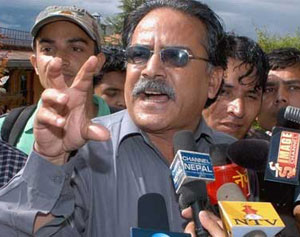KATMANDU - Nepal's Maoist leader Pushpa Kamal Dahal, known as "Prachanda," has now been sworn in as the first prime minister of the Federal Democratic Republic of Nepal, having won an overwhelming vote in the Constituent Assembly elected in April. The Assembly's opening action had been to vote almost unanimously to abolish the 239-year-old monarchy, and in June former King Gyanendra Shah departed from the palace, remaining in the country as an ordinary citizen.
Nepal fleetingly made headlines after the 2001 palace massacre of the previous monarch and his family. Its bloody ten-year civil war, however, was seldom in the international limelight. So, too, the country's unique peace process has rarely gained outside attention since the guns fell silent two years ago. Yet, amid too many continuing conflicts and failing peace processes around the world, a success story deserves to be recognized and supported.
 |
| Prachanda: Daunting task ahead |
I came to Nepal in mid-2005, when human rights violations committed by both sides in the armed conflict, together with Gyanendra's crackdown on democratic rights as he seized absolute power, led the international community to support a monitoring presence from the United Nations High Commissioner for Human Rights. With no end in sight to a war with thousands of civilian victims, and democracy far from the horizon, nobody could have foreseen how Nepal's people would express their demand for peace and change.
The turning point was the April 2006 people's movement, when hundreds of thousands took to the streets for nineteen successive days. The king was compelled to hand power back to the political parties, while a peace agreement emerged that ended the conflict, bringing the Maoists into an interim parliament and government and promising elections to a Constituent Assembly.
The people's movement also took the lid off social pressures often disregarded by Nepal's elites. Although established as a unitary Hindu kingdom, with politics directed from the Himalayan foothills, today around half the population live in the fertile southern plains and more than one-third are from over 50 indigenous, largely non-Hindu communities. Others are also historically marginalized from the social and political life of the nation, notably the Dalits, sometimes known as "untouchables," who are at the bottom of the Hindu caste system.
For these groups, the restoration of democracy was a step toward social transformation, enabling them to participate more equally in the life of the country. Given that the elections to the Constituent Assembly needed to ensure their representation, a complex system of quotas was devised. Along with the success of socially diverse candidates fielded by the Maoists, the Constituent Assembly that was elected in April represents an unprecedented array of marginalized groups.
Women, too, had been almost invisible in political life - and, indeed, in the peace process. Now nearly one-third of the Constituent Assembly's members are women - the highest proportion in South Asia and fourteenth place in the world for nationally elected bodies.
The challenges that face Prime Minister Prachanda, the incoming coalition government, and the Constituent Assembly, are immense, and trust is fragile. The Nepali Congress Party, for example, has chosen to remain in opposition, dubious of the Maoists' commitment to democratic politics.
Nowhere in the world is the transformation of an armed insurgent group into a peaceful political movement quick or easy. The Maoists enter the government still with their own army - confined to cantonments, with their weapons stored under UN monitoring - and a Young Communist League that has persistently acted outside the law. Commitments to resolve the future of the Maoist combatants, along with what the peace agreements call the "democratization" of the state army, must now be implemented.
But the biggest challenges go to the roots of the insurgency: poverty, injustice, and discrimination. One cost of the conflict has been the retreat of local governance and arrested development in a desperately poor country where over 80% of the population lives in rural districts.
Moreover, as Nepal aspires to become a federal democratic republic, expectations are high among diverse groups for greater control of their lives and resources. But what federalism will mean in practice, taking account of the geographic and ethnic peculiarities of Nepal, remains elusive and potentially divisive. Reaching a national consensus will be a formidable task for the Constituent Assembly, and meanwhile the Nepali people cannot be expected to wait patiently until a new constitution is drafted to see real improvement in their daily lives.
But there is reason to be hopeful. Nepal's peace process has been truly indigenous: it has not been mediated or managed by any external party. The UN has encouraged and facilitated the process - through quiet good offices during the last years of the conflict, human rights monitoring, assistance to the Constituent Assembly election, and monitoring arms and armies during the transition.
The Maoist and non-Maoist parties have asked the UN to maintain a political presence while the issue of the former combatants is resolved, and we stand ready to support peace-building, recovery, and long-term development. But the world, too, must be generous and steady in assisting Nepal to sustain the still fragile success of a remarkable peace process.
(Ian Martin is the United Nations Secretary-General's Special Representative in Nepal.)
Copyright: Project Syndicate, 2008. Exclusive to The Sunday Times |

